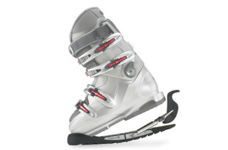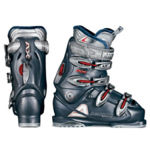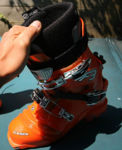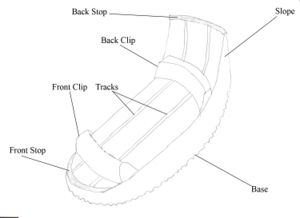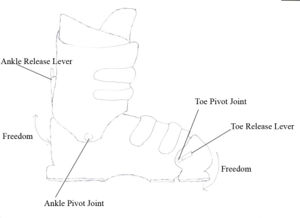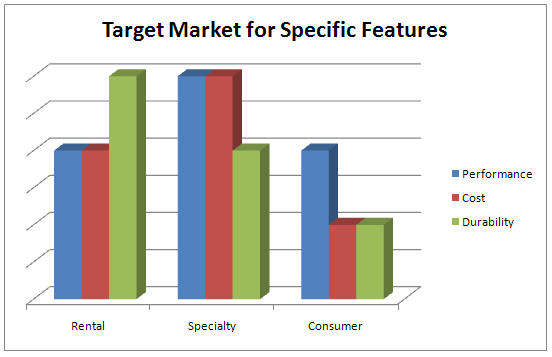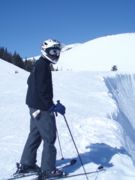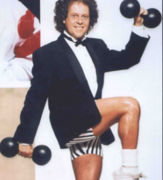Ski boot walking attachment redesign
From DDL Wiki
Acting upon the recommendations set forth in the previous report concerning problems related to walking in ski boots, this report presents further analysis of consumer needs as well as potential solutions. Skiers report near-universal annoyance at having to walk in their boots; some cited safety concerns. Most were satisfied with the trade-offs of carrying an attachment such as the WalkEZ if a significant stride benefit is to be had. The recommended solution is a boot attachment which employs translational and rotational freedoms to simulate normal foot movement despite a boot-locked ankle.
Contents |
Extended Summary
The previous report stated the following:
- Skiing is a large, well-funded industry with millions of participants each year
- Most skiers must walk in their boots, a task which is seen as uncomfortable and dangerous.
- The WalkEZ device provides some improvement to the gait, but additional improvement is recommended.
Therefore, this continuation of the above work contains the development of a further recommendation: a product. To arrive there, market research was considered. Skiers reported annoyance with walking, saying it was unsafe and uncomfortable. Respondents had minimal exposure to the WalkEZ, and upon trying it were "underwhelmed." The consensus was that a design providing great improvement to the step would be "worth" purchasing and carrying. However, different market groups have different needs: serious skiers demand high performance, whereas casual skiers value cost. Other needs include durability, portability, universality, and usability.
After brainstorming and generating ideas of varying impracticality, three designs were identified as feasible and worthy of further consideration. Two are attachments: one involves a sliding track, giving the boot lateral freedom; the other is a spring-damper revision of the WalkEZ, supplying angular freedom to the ankle. Pugh analyzes indicate the track and spring-damper designs are 'in the green' and merit yet further refinement.
The final solution recommendation is a product similar in nature to the WalkEZ - a combination of the track and spring-damper designs. It attaches via standard binding clamp action to the ski boot, and provides both a track and damped cushioning. Pugh analysis of the final design versus existing solutions shows it to be the winner. The next step will be to prototype this design and present it for review.
Market Research
Fourteen skiers were approached during the market research, in which eight were recreational skiers and six were the Carnegie Mellon Ski Team. We asked them their opinions on their concerns of walking in ski boots and where they wanted to see improvements in. Then, if they were aware of any existing solutions, we also requested additional information on what they felt of those solutions. Since most of the skiers that were approached had no clue of what the Walk-EZ Revolutions were, we had the skiers to try them on. With minor adjustments, they were all able to fit in the walking attachment; and afterward, they gave us their feedbacks.
Survey
There was a general consensus on the uncomfortable nature of walking in ski boots. Most of the recreational skiers wanted to see more flexibility in the boots, specifically around the ankles. Some of their responses were:
- “I just want to be able to bend at the ankles to get more mobility”
- “... the main issue is the flexibility of the foot. I don’t know if this would be possible, but maybe some mechanisms that allow the sole to bend for walking so you can bend your toes a bit.”
- “I would increase flexibility in the leg.”
Several of the serious skiers didn’t want any change on the boots that compromises the structural integrity of the boots and thus reducing the performance. By providing more flexibility to the boots, this provides less support for the ankles and thus jeopardizes the safety of the skier, especially when going fast. Listed below were some experts' views on increasing the flexibility of the ski boot:
- “In My experience there's not much you can do about it…there's always a trade off between comfort and performance.”
- “The other option is something like Tele-boots, which would have the movable toe built-in. I worry about a solution like that compromising boot response and stiffness though when in a binding along with insulation/leakage at the joint.”
- “I'd rather have a good experience skiing than a good experience walking around.”
The skiers agreed on the need of more flexibility around the ankles area when walking in ski boots, especially when walking up and down the stairs, but maintaining the rigidity to provide the support when skiing.
Existing Solutions
Several attempts on trying to solve this problem have been proposed in the past. All of them have been unsatisfactory or create more problems than they solve. The three most common solutions to this issue are unbuckling the clips on the boots, ski-walk adjustment, and the Walk-EZ Revolutions walking attachments.
Unbuckling the Boots
One way to walk easier in ski boots is to unbuckle the clips that fasten a skier’s foot to the boot. By unbuckling these clips, it allows a greater degree of freedom for the skier’s ankle to rotate because the shin is not held against the stiff outer shell that typically provides the support for the ankle. This outer shell protects the ankles and feet from injury while skiing but presents mostly comfort issues while walking. This practice however, becomes a hassle for unexperienced or young skiers. They would unlatch the clips to walk, and whenever they want to go back on the slopes, they would require assistance in buckling their boots back on. Although some people don't mind the hassle of unbuckling and buckling the clips, like one skier mentioned, "I find unbuckling the boots to work just fine and don't mind doing the John Wayne walk", generally speaking, this is a very inefficient way to acquire some comfort for just a simple task as walking.
Ski-Walk Adjustment
This adjustment allows the boot's upper cuff to hinge backward. This will give the skier the room needed for a more natural walking motion. Although this is a useful feature, most skiers would choose a more solid rear support in favor of walking comfort. Higher end boots will not have this feature for the reason that ski boots are not built to flex backward because the mechanism often causes the ski boot to lack a rearward support. All of the people who have tried this feature agree that this mechanism doesn't really work, as a few skiers claimed, "The lock/unlock mechanism doesn't really make very much of a difference because it doesn't provide a very significant degree of freedom" and "I always thought locking-unlocking things don't really improve anything." It provides inconsequential degree of freedom for walking, but the smallest change in the mobility of the boot while skiing dramatically affects the way one skis.
Walk-EZ Revolutions Walking Attachment
These are clip-on attachments for the soles of ski boots that provide a safe, gripping surface and have a curved form which allows a skier to walk more naturally. The addition of a simple, subtle curve to the bottom of the Walk-EZ allows the wearer to walk around in a natural, relaxed posture - eliminating the 15-degree angle/cant automatically imposed on your spine when in ski boots. In addition, an ingenious double hinge allows the units to fold flat for easy storage when not attached to the bottom of the boot. Even though, this device transforms into something more compact, skiers would still rather deal with the discomfort of walking in ski boots than carrying two more things, as some skiers said, "I would love to use something like walk-ez, but I would hate to carry them while not in use, especially when you consider that you ski for several hours (in my case around 5 to 7 hours a day) and you walk for just 15-30 minutes a day" and "The down-side to this is that you have to put them on/take them off to walk in them. What if there were some kind of integrated flip-down version of this that stows away on the back of your boot or something. Might be a good start rather than lugging around extra gear in your camel-back." This was perhaps the best attempt in trying to solve the crisis in walking in ski boots.
Products
Improvisations
Placeholder.jpg
Shoes. |
Initial Concepts
Introduction
When we began thinking of ideas to help make walking in ski boots a little bit more comfortable, we weren't sure exactly were improvements needed to be made. We considered making new types of ski boots, propulsion systems for the ski boots, attachments to make the motion more natural, and even creating a new transportation system on the ski slopes themselves.
Ultimately, we arrived at the conclusions that new boots might be a little too expensive and inconvenient for the average skier to buy, that a propulsion system would be too dangerous and difficult to make entirely feasible, and new transportation networks on the ski slopes is too large-scale a project for this class. In the end, an attachment seemed to be the most logical solution. We judged our ideas with the following criteria:
- Size/Weight - If the attachment is too large to fit comfortably in a small bag or in a pocket, then a majority of the target market would probably find it more annoying than helpful. Additionally, it needs to be lightweight since our market research indicates that a majority of skiers do not want to carry around a heavy set of walking attachments. Compact, minimal design is necessary for our product.
- Durability - If the product breaks after only a few uses, it will upset the customer and probably lead to minimal use and low customer goodwill.
- Intuitive Design - The product needs to be easy-to-use so that a potential customer can glance at it and immediately understand how they'll be using it. If it's operation procedures aren't immediately apparent, it may scare away potential customers because it appears too complicated.
- Effectiveness - If the product doesn't work very well, no one will want to buy it and it will meet the same fate as the essentially useless Walk-EZ attachment.
- Universal - We need a product that can be used by all people with all different boot sizes. If we exclude any market segment, not only do we lose their business, we also lose the business of people associated with those that we alienate. In addition, the attachment ideally would be able to fit on all existing boots.
- Cost - The cost is another huge issue because many skiers don't find walking in ski boots to be too big a problem and they'll simply deal with it. If our product is cheap enough, we can reach even the market that doesn't believe in the necessity of the product.
Track
The track design uses an idea similar to that of the Walk-EZ except that it allows the boot to move within the attachment, allowing for a more natural motion. The key components are as follows:
- Front Clip/Back Clip - The front and back clips hold the front and back of the boot, respectively, in place. This allows a rigid connection between the boot and the walking attachment that ensures no slippage.
- Tracks - The tracks allow the front and back clips to slide back and forth across the walking attachment. This allows the users boot to slide backwards a little bit when the ball of their foot would normally be rolling along the ground when walking. Within the track, there is a noticeable amount of friction to dampen the motion so that the user doesn't feel like they are sliding too much while walking.
- Slope - The slope makes sure that the back stop doesn't go too far back and helps restore force when the foot returns to a horizontal position.
- Front Stop/Back Stop - The front and back stops prevent the front and back clip, respectively from sliding off of the attachment.
- Base - The base is designed based off of the Walk-EZ base. The base has a rounded bottom to make the actual step more natural and there is also tread on the bottom to help the attachment maintain its grip.
Some of the major drawbacks of the track design are that it is physically very large, probably would have durability issues, and would probably be very costly. With the giant slope on the back of the attachment and the thick base, the device would have to be obtrusively large, and our market research indicates that this is a major issue. The slope would also make it much more difficult to have a folding feature or something similar. Because the clips are stuck on a track, they would probably break or fall off with extensive use. Finally, because it is very large and requires a complex system of clips and tracks, the device would exceed the price range of the average skier.
Some positive aspects of the device are that it would probably drastically improve the motion of walking for the user and that it would be pretty adjustable and available in many different sizes. The design allows your foot to follow a much more normal path than walking with a typical ski boot.
Spring-Damper
Hinged Boot
The existing hinged boot only has an ankle release and thus only gives your ankle increased range of motion. Walking comfortably, however, requires more than rotational freedom of the ankle. To win the other half of the battle, you need to have some flex in the foot itself. In our revised hinged ski boot design, we added another pivot joint in the toe so that your foot can flex naturally with each step.
Our design works by having two levers that can be switched to an open position. When in this open position, the normally tightly bound plates are released and able to pivot about joints in strategically placed locations. With this additional freedom, the motion of a step becomes much more natural.
The major shortcomings of this idea are that it may work less than ideally, many skiers might not opt to buy entirely new boots so that they can walk slightly more comfortably, and the boot might lose some rigidity needed for skiing. According to our market research, the existing boots with similar features really don't do a whole lot to improve the comfort of walking, so it isn't guaranteed that our revised design will help enough to warrant purchasing it. Also, according to our market research, many of the skiers felt that walking isn't an enormous problem, so unless the solution is cheap, they probably wouldn't buy it. Finally, if the locking mechanism wears out over time, the ski boots may lose the rigidity necessary to ski.
Even with all of the bad features of this design, it isn't without its merits. This design is incorporated into the boot itself, so it isn't necessary to carry any extra weight or annoying devices. Also, the added motion would probably help smooth out a step at least to some degree.
Comparison with Existing Solutions
Pugh Chart - Initial
A Pugh Chart quantitatively compares product designs based on several qualities. The chart evaluates the design's overall quality by its total score calculated by multiplying its grade in each of the categories that are weighed differently according to the category's significance to the product improvement. In general, a Pugh Chart uses the score of zero for the design that currently is the main stream in the market. The score of a new (or proposed) design is evaluated by whether the design is better, equally as good, or worse compared to the in-stock design in each of the categories the product is graded on. Below is the Pugh Chart comparing four conceptual designs of the ski boot walking attachment - as described above, the score of "0" indicates that the design is indifferent from the standard walking attachment, Walk EZ.
Concept 1
The first conceptual design presented yields a total score of 3, implying that the design's overall quality is better than the currently existing walking attachment. The design's superior performance over the currently existing attachment and the ease for the users to attach the product to their ski boots contributes to the biggest margin of positives (8) among the three designs listed. However, the design also features very high cost, requires extra physical inputs from the users and may pose some safety issues as the design's lack of durability. Although its cost the design's biggest weakness may not be the most significant aspect of the product for the target consumer group, the high cost of the product would certainly hinder the design's appeal to a wider range of consumers. Also, the durability of the design and large amount of physical input required from the user sums up this high-risk high-reward design. While its significantly improved walking motion may bring a great customer satisfaction to some, several negative aspects of the design makes it a very risky product for the manufacturers to invest on.
Concept 2
The second conceptual design scores the overall score of 4, which ranks the best among the three designs discussed here.
Target Market
The end characteristics of the solution may 'assign' it to one or more ideal categories. The direct purchasers of the device can be grouped into serious skiers, casual skiers, and equipment rental companies. The tradeoffs and corresponding market segments are as follows:
Serious Skiers
Market research indicates that serious skiers are less concerned about cost than performance, and that the frequency with which they ski is relatively high. Their ideal product is:
- High performance
- Decently durable
Casual Skiers
Casual skiers, on the other hand, are cost-conscious above all else. They do not ski enough to require the highest durability and, with the right marketing and product reputation, are likely to employ any significant improvement. Their ideal product is:
- Low cost
- Good performance
Equipment Rental Companies
Rental companies rent to both casual and semi-serious skiers, and use high usage to defray the cost of equipment. Thus, an incredibly durable product would be viable for a rental company despite a high price. Accessories such as helmets and even clothing are common rentals alongside skis and boots, so it is not unreasonable to recommend a stride-improvement accessory as a good rental opportunity.
- Very durable
- Good performance
Selected Concept
Desired Traits
Theoretical Equivalence
Physical Form
Comparison
Pugh Chart - Final
Recommendations
Next Steps
Timeline
A Gannt Chart is often used as a convinient tool to visualize a project's progress. The chart descirbes what major task(s) needs to be completed in order for the next task to begin. The Gannt Chart posted below is the projected time line of this project. Due to the duration for the ordered materials and parts to arrive, the actual manufacturing of the first prototype may not start until as late as October 13th, which would leave only a week to modify the product to the form that can be presented at the first design review. In order to stay on pace, product analyses on the first prototype are planned to be conducted in parallel with the manufacturing process. While waiting on the parts to arrive, detailed prototype designs need to be developed in order to optimize the efficiency of the manufacturing process.
Gannt Chart displaying the projected timeline for major tasks
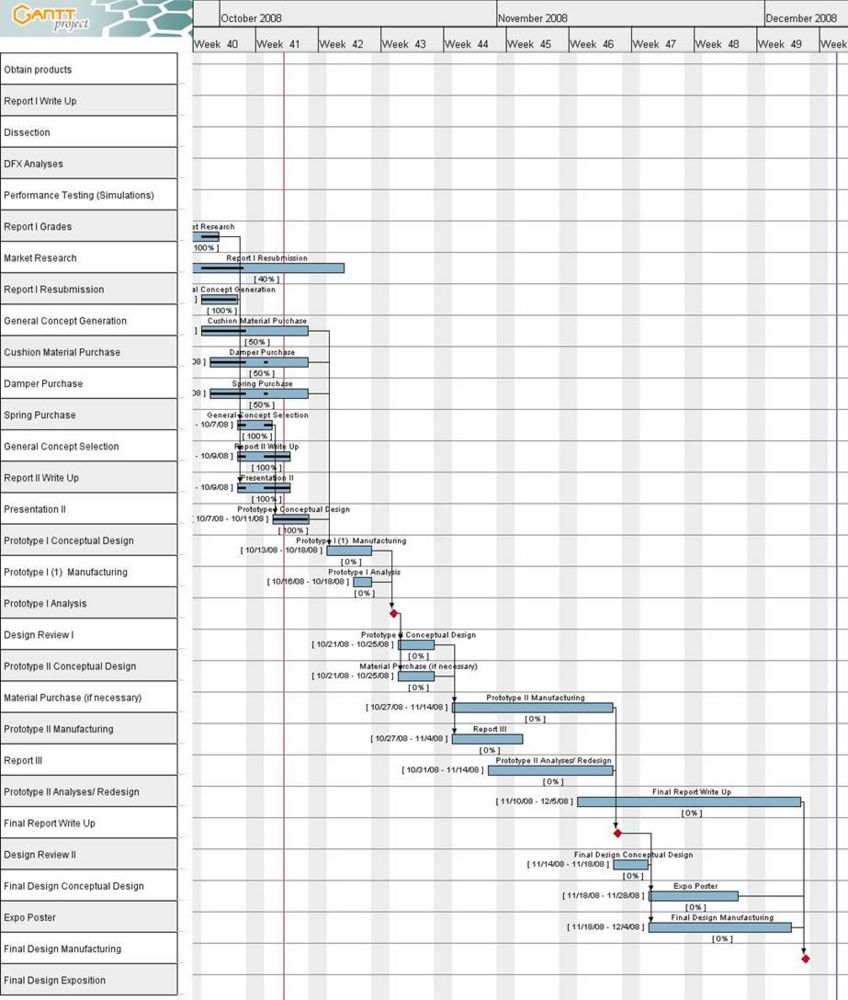
Although every major task between now and the Final Design Exposition are laid out in the Gannt Chart above, it is a "projected" timeline for the project. Therefore, the target deadlines for some of the tasks may be subject to change.
Team
Members
- Brandon Perry (Group Leader & Spokesperson)
- Executive Summary
- Target Markets
- Recommendations
- Presentation
- Randyka Pudjoprawoto (Product Specialist)
- Market research
- Existing solutions
- Sketches
- Taka Matsuura (Project Specialist)
- Market research
- Revision & editing
- Gantt chart
- Jarrett Valeri (Design Specialist)
- Demand analysis
- Idea & design development
- Documentation
Process
This stage of the design process saw our team working together more often. We used each other as a wall-ball court for ideas, spinning the idea of an "Eagle-powered ski boot" into a constructive foundation for more practical designs. When done separately, workload was divided evenly among the group members.
All members performed brainstorming, sketching, and participated in authoring this report.
Appendix
References
<references />
